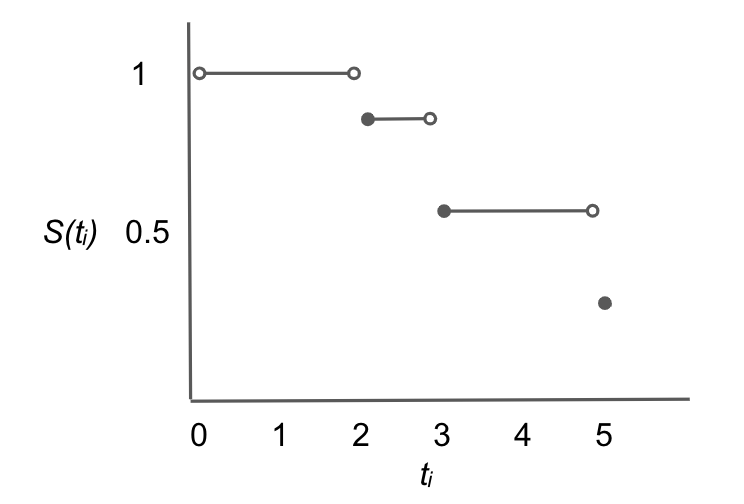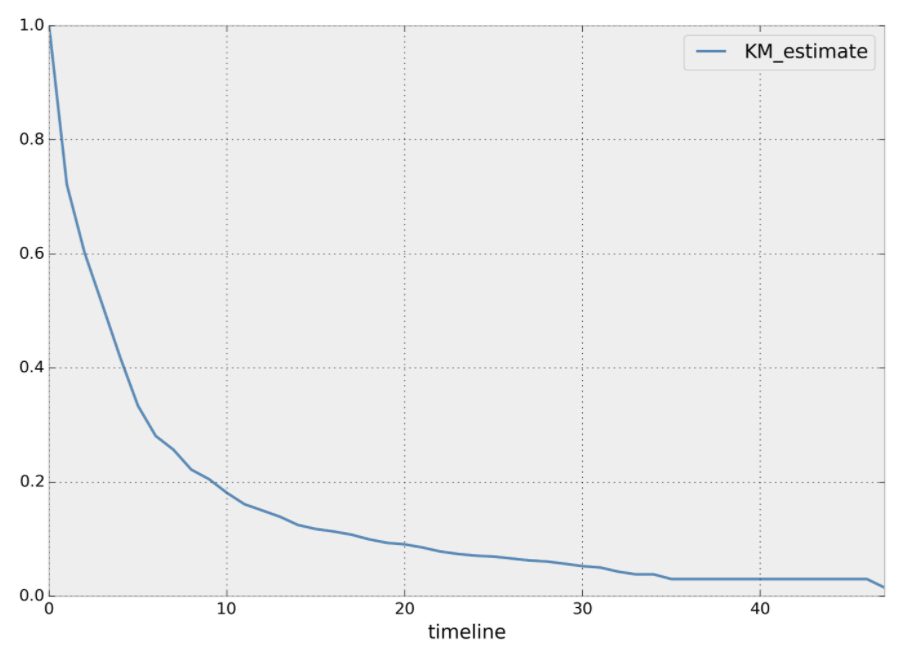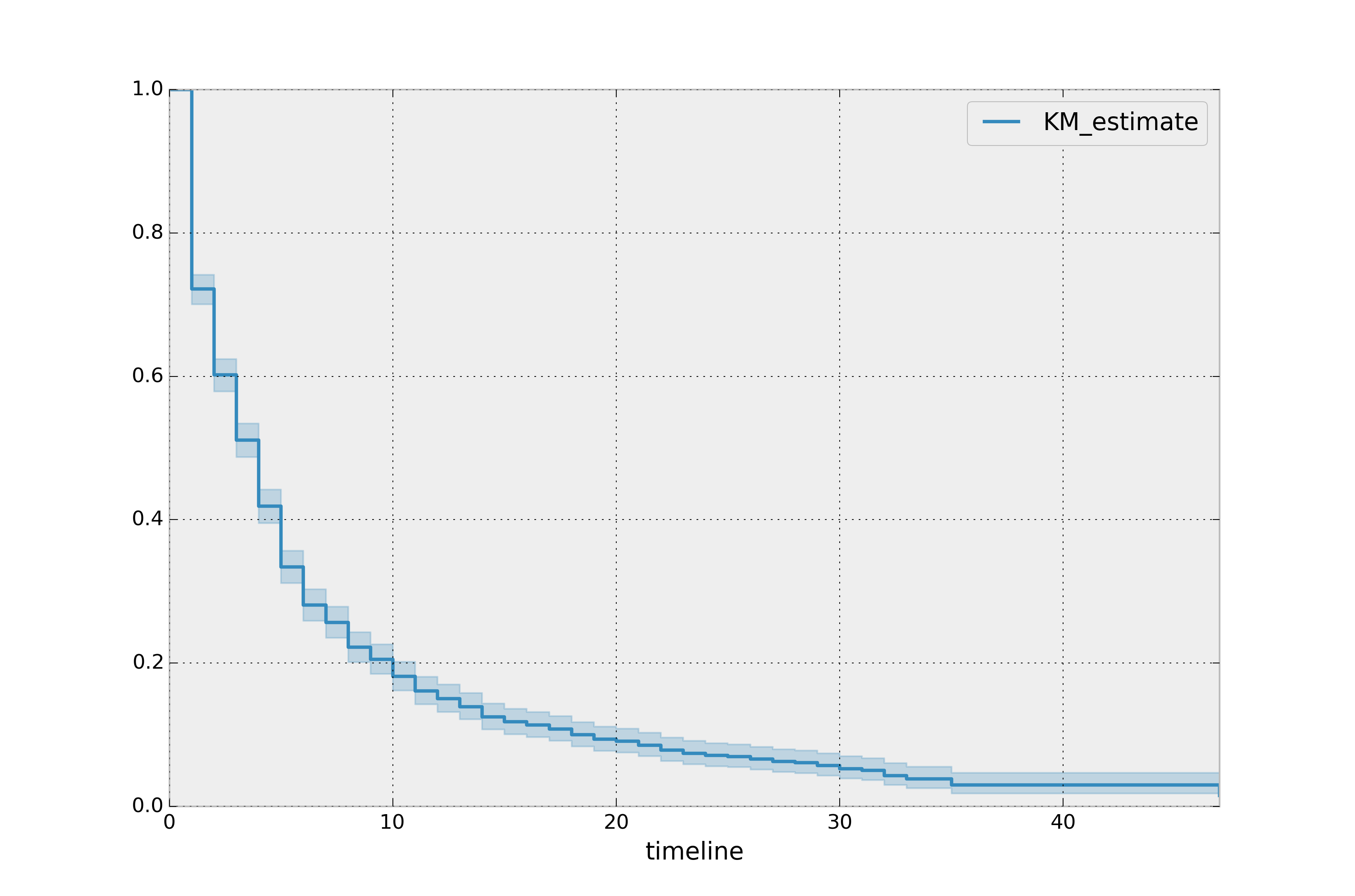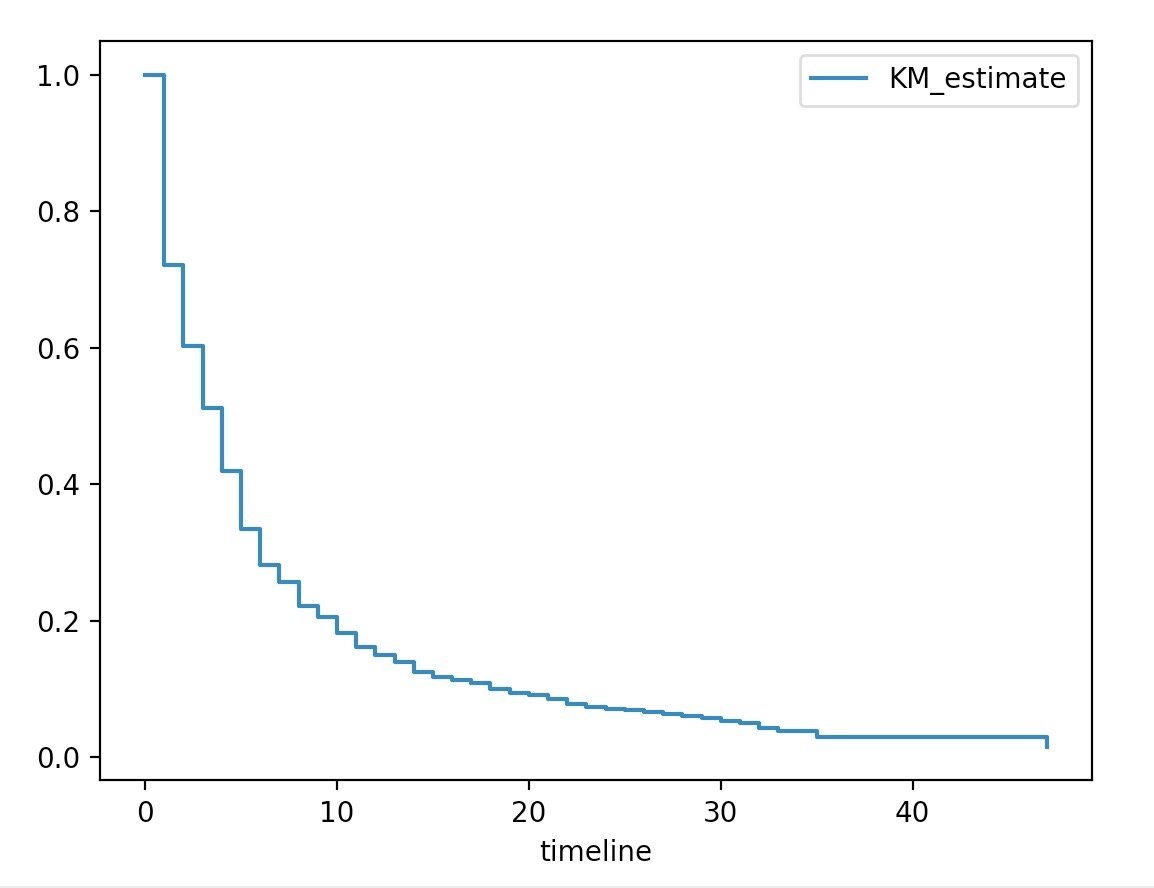Visualizing your Kaplan-Meier model
Survival Analysis in Python

Shae Wang
Senior Data Scientist
How to construct a Kaplan-Meier survival curve?
Toy data with $n=5$:
| duration | observed |
|---|---|
| 2 | 1 |
| 5 | 0 |
| 3 | 1 |
| 5 | 1 |
| 2 | 0 |
Step 1: Arrange data in increasing order. If tied, censored data comes after uncensored data.
Step 2: For each $t_i$, calculate $d_i$, $n_i$, and $\big(1-\frac{d_i}{n_i}\big)$
Step 3: For each $t_i$, multiply $\big(1-\frac{d_i}{n_i}\big)$ with $\big(1-\frac{d_{i-1}}{n_{i-1}}\big)$, $\big(1-\frac{d_{i-2}}{n_{i-2}}\big)$, ... , $\big(1-\frac{d_0}{n_0}\big)$
How to construct a Kaplan-Meier survival curve?
Step 1: Arrange durations in increasing order. If tied, censored data comes after uncensored data.
| duration |
|---|
| 2 |
| 5+ |
| 3 |
| 5 |
| 2+ |
Use "+" sign to denote censored data: 2, 5+, 3, 5, 2+
How to construct a Kaplan-Meier survival curve?
Step 1: Arrange durations in increasing order. If tied, censored data comes after uncensored data.
| $t_i$ |
|---|
| 2, 2+ |
| 3 |
| 5, 5+ |
How to construct a Kaplan-Meier survival curve?
Step 2: For each $t_i$, calculate $d_i$, $n_i$, and $\big(1-\frac{d_i}{n_i}\big)$
| $t_i$ |
|---|
| 2, 2+ |
| 3 |
| 5, 5+ |
How to construct a Kaplan-Meier survival curve?
Step 2: For each $t_i$, calculate $d_i$, $n_i$, and $\big(1-\frac{d_i}{n_i}\big)$
| $t_i$ | $d_i$ |
|---|---|
| 2, 2+ | 1 |
| 3 | 1 |
| 5, 5+ | 1 |
How to construct a Kaplan-Meier survival curve?
Step 2: For each $t_i$, calculate $d_i$, $n_i$, and $\big(1-\frac{d_i}{n_i}\big)$
| $t_i$ | $d_i$ | $n_i$ |
|---|---|---|
| 2, 2+ | 1 | 5 |
| 3 | 1 | 3 |
| 5, 5+ | 1 | 2 |
How to construct a Kaplan-Meier survival curve?
Step 2: For each $t_i$, calculate $d_i$, $n_i$, and $\big(1-\frac{d_i}{n_i}\big)$
| $t_i$ | $d_i$ | $n_i$ | $\big(1-\frac{d_i}{n_i}\big)$ |
|---|---|---|---|
| 2, 2+ | 1 | 5 | $4/5$ |
| 3 | 1 | 3 | $2/3$ |
| 5, 5+ | 1 | 2 | $1/2$ |
How to construct a Kaplan-Meier survival curve?
Step 3: For each $t_i$, multiply $\big(1-\frac{d_i}{n_i}\big)$ with $\big(1-\frac{d_{i-1}}{n_{i-1}}\big)$, $\big(1-\frac{d_{i-2}}{n_{i-2}}\big)$, ... , $\big(1-\frac{d_0}{n_0}\big)$
| $t_i$ | $d_i$ | $n_i$ | $\big(1-\frac{d_i}{n_i}\big)$ | $S(t_i)$ |
|---|---|---|---|---|
| 2, 2+ | 1 | 5 | 4/5 | 4/5 = 0.8 |
| 3 | 1 | 3 | 2/3 | 4/5 $\cdot$ 2/3 = 0.53 |
| 5, 5+ | 1 | 2 | 1/2 | 4/5 $\cdot$ 2/3 $\cdot$ 1/2 = 0.27 |
How to construct a Kaplan-Meier survival curve?
| $t_i$ | $d_i$ | $n_i$ | $\big(1-\frac{d_i}{n_i}\big)$ | $S(t_i)$ |
|---|---|---|---|---|
| 2, 2+ | 1 | 5 | $4/5$ | 0.8 |
| 3 | 1 | 3 | $2/3$ | 0.53 |
| 5, 5+ | 1 | 2 | $1/2$ | 0.27 |

Interpreting the survival curve

The survival probabilities at each time between 0 and 5.
Common misconception: If the curve goes to 0, no subjects survived.
- The curve will drop to zero if the last observation is not censored (true event duration is known).
Plotting the Kaplan-Meier survival curve
from lifelines import KaplanMeierFitter
import matplotlib.pyplot as plt
kmf = KaplanMeierFitter()
kmf.fit(durations, event_observed)
kmf.survival_function_.plot()
plt.show()
The mortgage problem example
DataFrame name: mortgage_df
| id | duration | paid_off |
|---|---|---|
| 1 | 25 | 0 |
| 2 | 17 | 1 |
| 3 | 5 | 0 |
| ... | ... | ... |
| 100 | 30 | 1 |
from lifelines import KaplanMeierFitter
from matplotlib import pyplot as plt
mortgage_kmf = KaplanMeierFitter()
mortgage_kmf.fit(duration=mortgage_df["duration"],
event_observed=mortgage_df["paid_off"])
mortgage_kmf.survival_function_.plot()
The mortgage problem example
plt.show()

Survival curve confidence interval
mortgage_kmf.plot_survival_function()
plt.show()

Why is the confidence interval useful?
- A way to quantify how uncertain we are about each point estimate of survival probabilities
- A wide confidence interval means we are less certain, often due to small sample size
- A narrow confidence interval means we are more certain, often due to large sample size
Ways to plot the Kaplan-Meier survival curve
Plot survival function point estimates as a continuous line.
kmf.survival_function_.plot()
plt.show()

Plot survival function as a stepped line without the confidence interval.
kmf.plot(ci_show=False)
plt.show()

Ways to plot the Kaplan-Meier survival curve
Plot survival function as a stepped line with the confidence interval.
kmf.plot()
plt.show()

Another way...
kmf.plot_survival_function()
plt.show()
Let's practice!
Survival Analysis in Python

